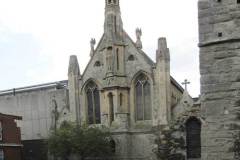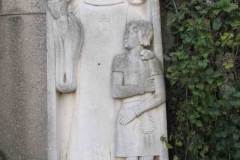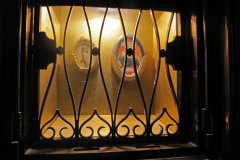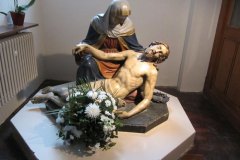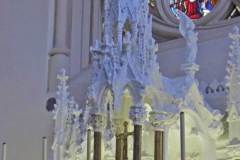Burgate Street
When St Thomas’ church opened for worship in 1875 it was the first Roman Catholic church to operate within the city since the reformation. During the preceding years local Catholics had met over a mile away
at the Hales Place chapel. The new building, designed by the Canterbury architect John Green Hall (who also designed the Congregational Church in Guildhall Street), stood beside the site of St Mary Magdalen church which had been substantially demolished in 1871 (Image 1). Given the restrictions of the available site, the church alignment does not follow the norm of an eastern alter and western tower. Depicted by The Times as ‘small and unpretending’, the church was built of Kentish rag stone with Bath stone windows and tracery, and grey stock bricks. An earlier plan to build on a site in Stour Street had failed. The new church suffered minor blast damage during the Baedeker raids but survived intact, and was extended towards Canterbury Lane in 1962.
What to see:
- The large stone relief to the right of the central tower depicting Pope Gregory and an Anglian slave (Image 2). (Gregory before he was Pope was impressed with the fair complexion of Anglian slaves and remarked ‘Angels not Anglians’) This originally stood in St Gregory’s chapel Chartham but on the closure of St Augustine’s Hospital in 1994 was transferred to Canterbury. Here, it was blessed in 1997 by the Archbishop of Southwark to mark the 1400th anniversary of the arrival of Augustine in England
- The two claimed relics of St Thomas (Image 3) kept in a small display chest above the alter of the Martyrs’ chapel – one a finger bone presented to the church in 1953 by a collateral descendant of Saint Thomas Becket (Father Thomas Becquet, Prior of Chevetogne in Belgium), the other a piece of St Thomas’ vestment given to the church in the 19th century
- The large pieta which came to the church from Hales chapel, purchased for 10 guineas by the parish priest in 1928 when the house was sold by the Jesuits (Image 4)
- A model of how Becket’s tomb might have appeared (Image 5)
- The leaflet available in the church on the Oaten Hill martyrs – four Catholics who died for their faith just outside the City
Access: open to the public most days – for contact details see web site
Sources: The Times 14 April 1875; Crabtree (2002); brochure available in the church
DL

